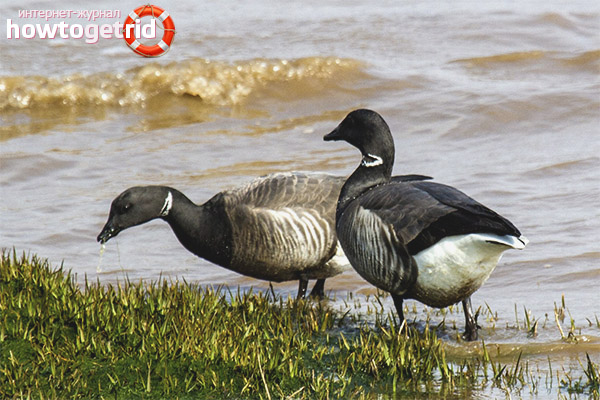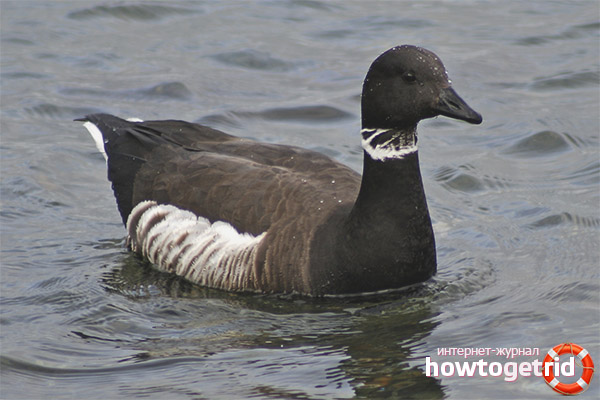The content of the article
The flight of black geese is distinguished by extraordinary beauty. The bird belongs to the genus Branta and is its smallest representative. When flying, this feathered representative can cover a distance of thousands of kilometers, although, at first glance, its flight is very difficult. In flight, the bird often flaps its wings. When migrating, the shape of the flock has a wavy line. The height from the ground during the migration flight is small. Local movements are carried out in the form of a close heap, flying at a slight height from the ground or water. The flight is accompanied by the publication of the characteristic quiet loud cries.
It lives on the Arctic Circle. It can be found on the coast of the Arctic seas, islands located in the Arctic Ocean.
External data
The variability of geography leaves an imprint on the coloring of the body from the upper and lower sides.The bird carries out migratory flights in two directions. This circumstance allows us to distinguish two groups. One of them includes representatives who show a desire to the northern shores of the Atlantic Ocean, and the flight direction of the birds of another group is the Pacific Ocean.
This bird is the smallest of all geese. Its value is close to the size of the domestic duck. The length of the body can reach 69 cm, and weight - about 1.8 kg. The bird is characterized by the presence of three subspecies. Their differences are in color. In adulthood, the bird has a black head, chest and neck. The back has a dark gray color with a black border. The body at the bottom and on the sides is gray.
Dimensions of males are somewhat larger than those of females. Young birds do not have a white collar, which is characteristic of a juvenile outfit with a common brownish plumage tone. In the second year of bird life, the disappearance of a brownish raid is observed. But in return, his bird is characterized by the appearance of a white collar. During this period, the formation of puberty is not yet complete.
Paws and beaks are painted black. It received its name not by chance.It was the black color that gave reason for the bird to be called that way.
This goose has a very silent manner of behavior. If a bird starts to say something, then its speech is like a nasal mutter. During the flight, the bird's voice can be heard only when it is located at a distance close to the person.
Prevalence
Representatives of this species can be found in western Europe on its northern coast. She lives in the north of Germany, Denmark, the Netherlands. But the distribution area is not limited to these countries. It can also be found in the south-east of the British Isles. It is also found on the French Atlantic coast. In our country, its habitat is Chukotka and Yakutia.
Now in the wild, there are about half a million representatives of this species. A sharp decline in numbers could be observed in the 70s of the last century. This was due to the absence of a ban on hunting them. At present, hunting is prohibited, but the threat of reducing the number of species remains. This is due to the fact that grain fields are a favorite place for grazing geese.It is not difficult to guess that they, therefore, become the object of extermination.
Subspecies
The bird has three subspecies. Each of them has a black color, but with distinction of color on the sides and belly:
- Branta bernicla hrota. The subspecies have a bright belly and a pale brown shade of feathers. Breeding goose of this subspecies in the territory of Canada. Greenland is also a nesting site with nearby islands. This hunt is prohibited any hunt.
- Branta bernicla nigricans. Birds with a black belly. Nesting is carried out on the territory of North America, in our country - on the Siberian expanses.
- Branta bernicla bernicla. Representatives of this subspecies have a dark belly. Nesting is carried out in the northern European and Asian territories.
Habitat
The habitat of the black geese is the northern tundra. It can also be found in wet meadows, where there is low grassy vegetation. Nests are arranged on gentle banks richly covered with salt marshes. But she can arrange nests and where there are grassy islands. Usually their location is associated with the river delta and ponds.
A favorable environment for its habitat is the coastal strip of water bodies. During the migration flight, the bird stops to rest in places where there are flooded muddy shores. Undoubtedly, the fields with grain crops are interesting for birds.
Lifestyle characteristics
This species is characterized by pronounced migration. A flock with migration has a fairly good density. The flight speed of birds is considerable and can reach 90 km per hour. Such high rates of speed are achieved by the presence of its long and narrow wings. Along with seasonal flights, migrations are possible during the day. In the place of feeding the bird is a couple of hours, and then flies towards the sea for a watering place. There they will stay until the middle of the day. At this time they drink water and rest.
From the second half of the day, they again go in search of food to the coast and spend time there before sunset. The place of their overnight stay is the open sea.
Breeding
In order to reproduce the birds are kept in pairs. Small colonies are formed from the formed pairs. The emergence of chicks occurs almost simultaneously. At first, the newly born chicks just do what they eat.To feed them it takes up to 13-14 hours a day. This will continue until the chicks fled. They spend the winter together with their parents. The sexual specimen is formed in 2-3 years.
Nest suits near the reservoir. There are examples of broods in icy tundra. The bird builds nests from diverse vegetation in combination with its own down. Basically, the female can carry 3-5 eggs. In very rare cases, their number can reach up to seven. The eggs of the female incubate for 24-26 days.
The ritual of grooming a male for a female is very complex in nature. These birds form one pair for life. They mate in water.
Feeding in captivity
The bird needs a sufficient amount of food, consisting of vegetable components. In addition, sprouted grains are used in the feeding of young birds.Favorite delicacy - salad. If the grass in the aviary is not suitable for nutrition, a certain amount of freshly cut grass is added to the diet. In addition, they give compound feed, which is intended for chickens, as well as pellets intended for feeding waterfowl representatives.
Video: black brant (Branta bernicla)













To send